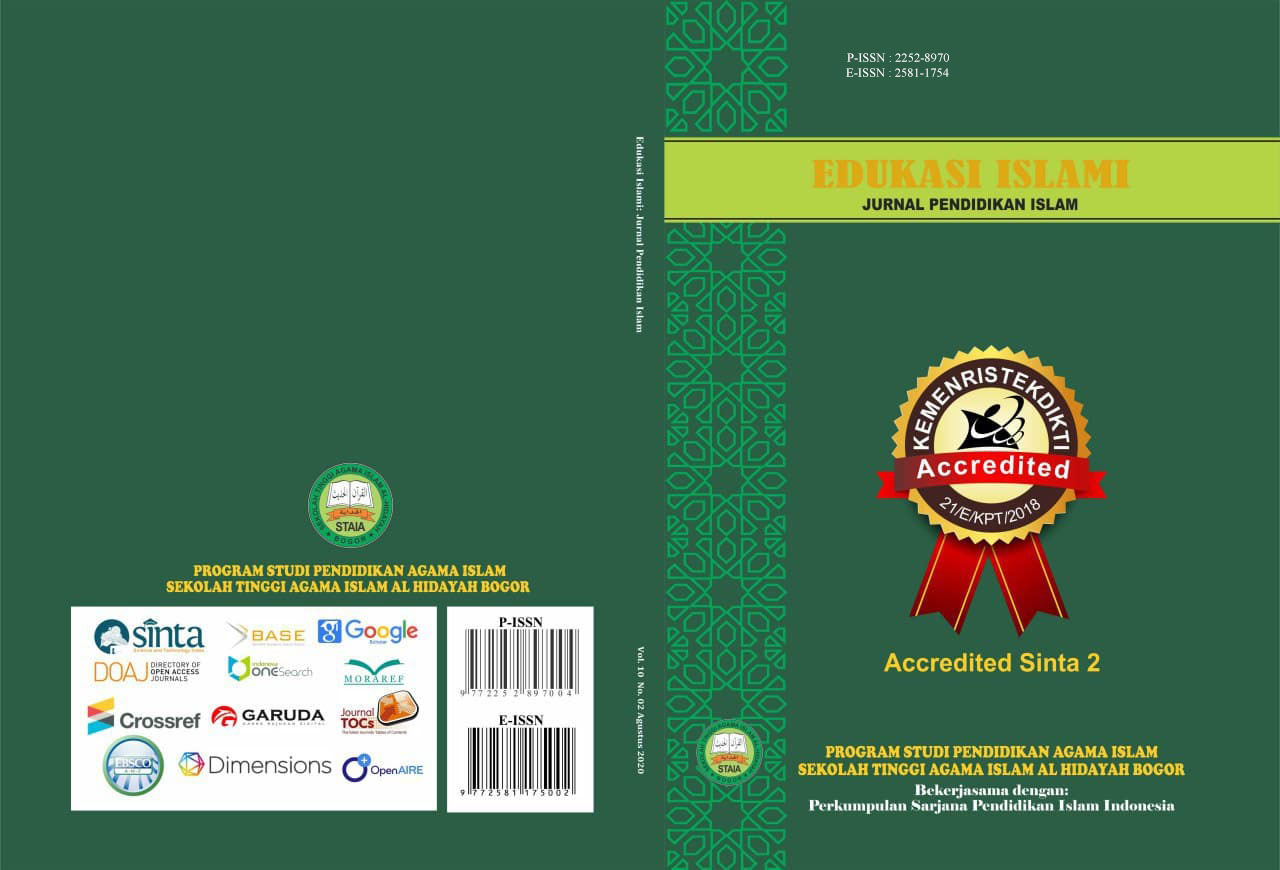Implementasi Metode Talqin Dalam Membina Hafalan Al-Quran Santri Tunanetra Di Pesantren Disabilitas Generasi Qurani Cipanas Cianjur
DOI:
https://doi.org/10.30868/ei.v12i001.5592Keywords:
Talqin Method, Memorizing Al-Quran, Blind StudentsAbstract
One of the processes of learning the Koran is by memorizing it, the talqin method is one solution to enable blind students to memorize the Koran. The formulation of the problem of this research is: 1) How is the implementation of the talqin method for blind students in memorizing the Al-Quran at the Qurani Generation Disability Islamic Boarding School, 2) What are the supporting factors and obstacles to implementing the talqin method for blind students at the Qurani Generation Disability Islamic Boarding School, 3) What are the results or impacts of applying the talqin method in memorizing the Al-Quran for blind students at the Qurani Generation Islamic Boarding School with Disabilities. This type of research is a qualitative type of research, the data collection method uses: 1) Observation, 2) Interview, 3) Documentation. The results of this research show that the implementation of the talqin method in memorizing disabled students at the Qurani Generation Islamic Boarding School with Disabilities, the process begins with a tahfizh teacher modeling reading with certain systematics and repetitions, then the students follow it until they produce reading or memorization as exemplified. Supporting factors for applying the talqin method in developing the memorization of blind students: a) Media and Talqin Method, b) Muhafidz (Teacher), c) Role of Students, d) Role of Accompanying Teachers and Parents, e) Reweads. The constraining factors are facilities and infrastructure. The impact of implementing the talqin method in fostering student memorization at the Qurani Generation Disability Islamic Boarding School is that it makes it easier for blind students to memorize the Qur'an, especially for students who cannot read or use the Braille Al-Quran.
References
Armai, Arief Pengantar Ilmu Dan Metodologi Pendidikan Islam, Jakarta, Ciputat Press 2002
Departemen Agama RI, Al-Qur’an dan Terjemahnya, Bandung, Syaamil Al-Qur’an, 2007.
Depdikbud, Kamus Besar Bahasa Indonesia, Jakarta, Perum Balai Pustaka, 1988.
Efferi Adri, Materi dan Pembelajaran Qur’an Hadits MTs-MA, STAIN Kudus, 2009.
Hidayat Adi, At-Taisir Mushaf Hafalan, Bekasi Selatan, Quantum Akhyar Institute, 2018
Maftuhin Arif dkk, Islam dan Disabilitas:dari teks ke konteks, Yogyakarta, Gading 2020.
Manastas Lagita, Strategi mengajar siswa tunanetra, Yogyakarta, Imperium, 2014.
Nashr Yasir, Kecil-kecil jadi Hafizh, Sukoharjo, Kiswah Media,2015.
Sa’dulloh, 9 Cara Praktis Menghafal Al-Quran, Jakarta, Gema Insani 2008.
Solichin Wahab Abdul, Analisis Kebijakan, Jakarta,PT Bumi Aksara 2016.
Sugiono, Metode Penelitian Kuantitatif,Kualitatif dan R&D, Bandung, Alfabeta, 2019.
Wawancara dengan Aryo, (santri), pada 26 agustus 2021, di Pesantren Disabilitas Generasi Qurani
Zulkifli, Metodologi Pengajaran Bahasa Arab, Pekanbaru, Zanafa Publising, 2011.
Downloads
Published
Issue
Section
Citation Check
License
Authors who publish with this journal agree to the following terms:
- Authors retain copyright and grant the journal right of first publication with the work simultaneously licensed under a Creative Commons Attribution License that allows others to share the work with an acknowledgment of the work's authorship and initial publication in this journal.
- Authors are able to enter into separate, additional contractual arrangements for the non-exclusive distribution of the journal's published version of the work (e.g., post it to an institutional repository or publish it in a book), with an acknowledgment of its initial publication in this journal.
- Authors are permitted and encouraged to post their work online (e.g., in institutional repositories or on their website) prior to and during the submission process, as it can lead to productive exchanges, as well as earlier and greater citation of published work (See The Effect of Open Access).









